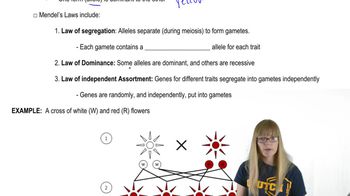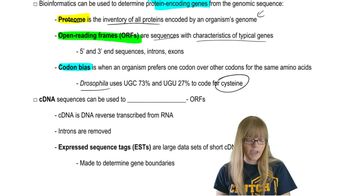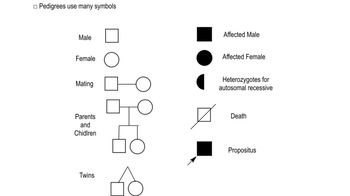Table of contents
- 1. Introduction to Genetics51m
- 2. Mendel's Laws of Inheritance3h 37m
- 3. Extensions to Mendelian Inheritance2h 41m
- 4. Genetic Mapping and Linkage2h 28m
- 5. Genetics of Bacteria and Viruses1h 21m
- 6. Chromosomal Variation1h 48m
- 7. DNA and Chromosome Structure56m
- 8. DNA Replication1h 10m
- 9. Mitosis and Meiosis1h 34m
- 10. Transcription1h 0m
- 11. Translation58m
- 12. Gene Regulation in Prokaryotes1h 19m
- 13. Gene Regulation in Eukaryotes44m
- 14. Genetic Control of Development44m
- 15. Genomes and Genomics1h 50m
- 16. Transposable Elements47m
- 17. Mutation, Repair, and Recombination1h 6m
- 18. Molecular Genetic Tools19m
- 19. Cancer Genetics29m
- 20. Quantitative Genetics1h 26m
- 21. Population Genetics50m
- 22. Evolutionary Genetics29m
2. Mendel's Laws of Inheritance
Pedigrees
Problem 50
Textbook Question
Select a human hereditary disease or condition you would like to know more about. Using the OMIM website (http://www.ncbi.nlm.nih.gov/omim), search for the disease and prepare a short synopsis of your findings. Include the following information:
Any available information about the population(s) in which the disease is most common.
 Verified step by step guidance
Verified step by step guidance1
Step 1: Choose a hereditary disease or condition that you are interested in learning more about.
Step 2: Visit the OMIM website at http://www.ncbi.nlm.nih.gov/omim.
Step 3: Use the search function on the OMIM website to find the disease or condition you selected.
Step 4: Review the information provided on the OMIM page for the disease, focusing on the sections that discuss population genetics and epidemiology.
Step 5: Summarize the findings, particularly any details about the populations in which the disease is most common, including prevalence rates and any known genetic factors.
Recommended similar problem, with video answer:
 Verified Solution
Verified SolutionThis video solution was recommended by our tutors as helpful for the problem above
Video duration:
3mPlay a video:
Was this helpful?
Key Concepts
Here are the essential concepts you must grasp in order to answer the question correctly.
Hereditary Diseases
Hereditary diseases are genetic disorders that are passed down from parents to offspring through genes. These conditions can be caused by mutations in a single gene (monogenic), multiple genes (polygenic), or chromosomal abnormalities. Understanding the inheritance patterns, such as autosomal dominant, autosomal recessive, or X-linked, is crucial for identifying how these diseases manifest in populations.
Recommended video:
Guided course

Mendel's Laws
OMIM Database
The Online Mendelian Inheritance in Man (OMIM) is a comprehensive, authoritative database that catalogs human genes and genetic disorders. It provides detailed information about the genetic basis of diseases, including their symptoms, inheritance patterns, and population prevalence. Utilizing OMIM is essential for researching specific hereditary conditions and understanding their genetic implications.
Recommended video:
Guided course

Bioinformatics
Population Genetics
Population genetics is the study of genetic variation within populations and how these variations change over time due to factors like natural selection, genetic drift, and gene flow. This field helps in understanding the prevalence of hereditary diseases in specific populations, as certain genetic disorders may be more common in particular ethnic or geographic groups due to historical, environmental, or social factors.
Recommended video:
Guided course

Descriptive Genetics

 2:48m
2:48mWatch next
Master Pedigree Symbols with a bite sized video explanation from Kylia Goodner
Start learning




